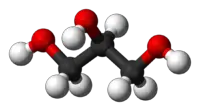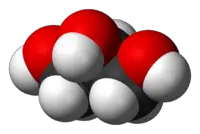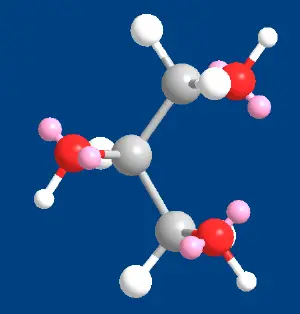Difference between revisions of "Glycerol" - New World Encyclopedia
(Reformatted notes.) |
|||
| Line 69: | Line 69: | ||
Until recently, synthetic glycerol was mainly manufactured at an industrial scale from [[epichlorohydrin]] though this process is no longer economical. Glycerol is a 10% by-product of biodiesel manufacture (via the transesterification of vegetable oils). This has led to a glut of crude glycerol on the market. Although this crude glycerol (typically containing 20% water and residual esterification catalyst) can be refined to a purified form, a great deal of research is being conducted to try to make value-added molecules from glycerol, as an alternative to [[incineration]]. One such programme to add value to this glut of glycerol is the UK-based initiative [http://www.theglycerolchallenge.org The Glycerol Challenge]. Some potential uses for glycerol include the following: | Until recently, synthetic glycerol was mainly manufactured at an industrial scale from [[epichlorohydrin]] though this process is no longer economical. Glycerol is a 10% by-product of biodiesel manufacture (via the transesterification of vegetable oils). This has led to a glut of crude glycerol on the market. Although this crude glycerol (typically containing 20% water and residual esterification catalyst) can be refined to a purified form, a great deal of research is being conducted to try to make value-added molecules from glycerol, as an alternative to [[incineration]]. One such programme to add value to this glut of glycerol is the UK-based initiative [http://www.theglycerolchallenge.org The Glycerol Challenge]. Some potential uses for glycerol include the following: | ||
*Hydrogen gas production | *Hydrogen gas production | ||
| − | *[[Glycerine acetate]] (potential fuel additive) | + | *[[Glycerine acetate]] (potential fuel additive) |
*Compost additive | *Compost additive | ||
*Citric acid production | *Citric acid production | ||
| − | *Conversion to [[propylene glycol]]<ref> | + | *Conversion to [[propylene glycol]]<ref>[http://www.dow.com/propyleneglycol/news/20070315b.htm. Propylene Glycol]. Dow Chemical. Retrieved September 14, 2007.</ref>. |
| − | *Conversion to [[acrolein]]<ref>Ott, L. et al | + | *Conversion to [[acrolein]]<ref>Ott, L. et al. 2006. The catalytic dehydration of glycerol in sub- and supercritical water: a new chemical process for acrolein production. ''Green Chemistry''. 8:2:214-220.</ref><ref>Watanabe, M. et al. 2007. Acrolein synthesis from glycerol in hot-compressed water. ''Bioresource technology 98''. 1285-1290.</ref> |
| − | * Conversion to [[ethanol]]<ref>http://www.sciencedaily.com/upi/index.php?feed=Science&article=UPI-1-20070625-13174400-bc-us-glycerin.xml</ref> | + | * Conversion to [[ethanol]]<ref>[http://www.sciencedaily.com/upi/index.php?feed=Science&article=UPI-1-20070625-13174400-bc-us-glycerin.xml Technology turns glycerin into ethanol]. Retrieved September 14, 2007.</ref> |
| − | *Conversion to [[epichlorhydrin]]<ref>http://epoxy.dow.com/epoxy/news/2007/20070326b.htm | + | *Conversion to [[epichlorhydrin]]<ref>{http://epoxy.dow.com/epoxy/news/2007/20070326b.htm Dow Epoxy]. Dow Chemical. Retrieved September 14, 2007.</ref>. [[Epichlorhydrin]] is a raw material for [[epoxy resins]]. |
==Metabolism== | ==Metabolism== | ||
| Line 120: | Line 120: | ||
*Used in medical and pharmaceutical preparations, mainly as a means of improving smoothness, providing [[lubrication]] and as a [[humectant]]. Also may be used to lower intracranial and intraocular pressures. | *Used in medical and pharmaceutical preparations, mainly as a means of improving smoothness, providing [[lubrication]] and as a [[humectant]]. Also may be used to lower intracranial and intraocular pressures. | ||
*Used at 10% to prevent tannins from precipitating in ethanol extracts of plants ([[tinctures]]). | *Used at 10% to prevent tannins from precipitating in ethanol extracts of plants ([[tinctures]]). | ||
| − | *Used as a substitute for alcohol, as a solvent that will create a therapeutic herbal extraction, but is less extractive and is approximately 30% less able to be absorbed by the body. [[Fluid extract]] manufacturers often extract herbs in hot water before adding glycerin to make [[glycerites]].<ref> | + | *Used as a substitute for alcohol, as a solvent that will create a therapeutic herbal extraction, but is less extractive and is approximately 30% less able to be absorbed by the body. [[Fluid extract]] manufacturers often extract herbs in hot water before adding glycerin to make [[glycerites]].<ref>Long, Walter S. The Composition of Commercial Fruit Extracts. 1916, 1917. ''Transactions of the Kansas Academy of Science (1903-). 28:157-161.</ref><ref>David Winston. http://www.herbaltherapeutics.com Herbal Therapeutics]. Retrieved September 14, 2007.</ref><ref>[http://www.newhope.com/nutritionsciencenews/NSN_backs/Apr_99/backtalk.cfm Does Alcohol Belong In Herbal Tinctures?]. Nutrition Science News. Retrieved September 14, 2007.</ref> |
| − | Walter S. | ||
*Used as a [[prochiral]] building block in [[organic synthesis]]. | *Used as a [[prochiral]] building block in [[organic synthesis]]. | ||
*Used as a [[laxative]] when introduced into the rectum in [[suppository]] or liquid ([[enema]]) form; irritates the bowel and induces a [[laxative#Hydrating agents (osmotics)|hyperosmotic effect]]. | *Used as a [[laxative]] when introduced into the rectum in [[suppository]] or liquid ([[enema]]) form; irritates the bowel and induces a [[laxative#Hydrating agents (osmotics)|hyperosmotic effect]]. | ||
Revision as of 01:57, 14 September 2007
- "Glycerine" redirects here.
| Glycerol | |
|---|---|
  
| |
| Chemical name | Propane-1,2,3-triol |
| Other names | glycerin glycerine propane-1,2,3-triol 1,2,3-propanetriol 1,2,3-trihydroxypropane glyceritol glycyl alcohol |
| Chemical formula | C3H5(OH)3 |
| Molecular mass | 92.09382 g/mol |
| CAS number | [56-81-5] |
| HS number | Crude: 1520.00.00 Pure: 2905.45.00 |
| Density | 1.261 g/cm³ |
| Viscosity | 1.5 Pa.s |
| Melting point | 18 °C (64.4°F) |
| Boiling point | 290 °C (554°F) |
| Food energy | 4.32 kcal/g |
| SMILES | OCC(O)CO |
| Flash Point | 160 °C (closed cup) |
| Supplementary data page | |
| Structure & properties | n, εr, etc. |
| Thermodynamic data | Phase behavior Solid, liquid, gas |
| Spectral data | UV, IR, NMR, MS |
| Disclaimer and references | |
Glycerol is a chemical compound with the formula HOCH2CH(OH)CH2OH. This colorless, odorless, viscous liquid is widely used in pharmaceutical formulations. Also commonly called glycerin or glycerine, it is a sugar alcohol and fittingly is sweet-tasting and of low toxicity. Glycerol has three hydrophilic alcoholic hydroxyl groups that are responsible for its solubility in water and its hygroscopic nature. Its surface tension is 64.00 mN/m at 20 °C and it has a temperature coefficient of -0.0598 mN/(m K). It is a central component of lipids.
Synthesis
Since glycerol forms the backbone of triglycerides, it is produced on saponification or transesterification. Soap making and biodiesel production are examples of the former and latter. Until recently, synthetic glycerol was mainly manufactured at an industrial scale from epichlorohydrin though this process is no longer economical. Glycerol is a 10% by-product of biodiesel manufacture (via the transesterification of vegetable oils). This has led to a glut of crude glycerol on the market. Although this crude glycerol (typically containing 20% water and residual esterification catalyst) can be refined to a purified form, a great deal of research is being conducted to try to make value-added molecules from glycerol, as an alternative to incineration. One such programme to add value to this glut of glycerol is the UK-based initiative The Glycerol Challenge. Some potential uses for glycerol include the following:
- Hydrogen gas production
- Glycerine acetate (potential fuel additive)
- Compost additive
- Citric acid production
- Conversion to propylene glycol[1].
- Conversion to acrolein[2][3]
- Conversion to ethanol[4]
- Conversion to epichlorhydrin[5]. Epichlorhydrin is a raw material for epoxy resins.
Metabolism
Glycerol is a precursor for synthesis of triacylglycerols and of phospholipids in the liver and adipose tissue. When the body uses stored fat as a source of energy, glycerol and fatty acids are released into the bloodstream. The glycerol component can be converted to glucose by the liver and provides energy for cellular metabolism.
Before glycerol can enter the pathway of glycolysis or gluconeogenesis (depending on physiological conditions), it must be converted to their intermediate glyceraldehyde 3-phosphate in the following steps:
| Glycerol | Glycerol kinase | Glycerol-3-phosphate | Glycerol-3-phosphate dehydrogenase | Dihydroxyacetone phosphate | Triosephosphate isomerase | Glyceraldehyde 3-phosphate | |||
| ATP | ADP | NAD+ | NADH + H+ |

| |||||

|

|

| |||||||
| NADH + H+ |
NAD+ | ||||||||
The enzyme glycerol kinase is present only in the liver. In adipose tissue, glycerol 3-phosphate is obtained from dihydroxyacetone phosphate (DHAP) with the enzyme glycerol-3-phosphate dehydrogenase.
Applications
Medicine and pharmaceutical technology
- Used in medical and pharmaceutical preparations, mainly as a means of improving smoothness, providing lubrication and as a humectant. Also may be used to lower intracranial and intraocular pressures.
- Used at 10% to prevent tannins from precipitating in ethanol extracts of plants (tinctures).
- Used as a substitute for alcohol, as a solvent that will create a therapeutic herbal extraction, but is less extractive and is approximately 30% less able to be absorbed by the body. Fluid extract manufacturers often extract herbs in hot water before adding glycerin to make glycerites.[6][7][8]
- Used as a prochiral building block in organic synthesis.
- Used as a laxative when introduced into the rectum in suppository or liquid (enema) form; irritates the bowel and induces a hyperosmotic effect.
- Cough syrups, elixirs and expectorants.
Personal care
- Serves as an emollient, humectant, solvent, and lubricant in personal care products.
- Competes with sorbitol although glycerol has better taste[citation needed] and higher solubility.
- Toothpaste, mouthwashes, skin care products, shaving cream, hair care products and soaps
- Glycerol is a component of glycerol soap, which is made from denatured alcohol, glycerol, sodium castorate (from castor), sodium cocoate, sodium tallowate, sucrose, water and parfum (fragrance). Sometimes one adds sodium laureth sulfate. This kind of soap is used by people with sensitive, easily irritated skin because it prevents skin dryness with its moisturizing properties. It is possible to make glycerol soap at home.
It was once believed that when used as an emollient, glycerol should never be applied undiluted to the skin. It was thought that the same powerful hygroscopic property that draws moisture out of the air to moisten the skin will draw moisture out of the skin if the glycerol is too concentrated. This in fact has proven to be untrue.[citation needed]
Foods and beverages
- Serves as humectant, solvent and sweetener, may help preserve foods.
- Solvent for flavors (such as vanilla) and food coloring.
- Humectant and softening agent in candy, cakes and casings for meats and cheeses.
- Manufacture of mono- and di-glycerides for use as emulsifiers
- Used in manufacture of polyglycerol esters going into shortenings and margarine.
- Used as filler in low-fat food products (i.e., cookies).
- Used as thickening agent in liqueurs.
- Produced when butter becomes rancid.
Glycerol has approximately 27 calories per teaspoon and is 60% as sweet as sucrose. Although it has about the same food energy as table sugar, it does not raise blood sugar levels, nor does it feed the bacteria that form plaques and cause dental cavities. Glycerol should not be consumed undiluted, as unhydrated glycerol will draw water from tissues, causing blistering in the mouth and gastric distress. As food additive, glycerol is also known as E number E422.
Feed
Glycerol is increasingly used in feeding animals.[citation needed]
Polyether polyols
- One of the major raw materials for the manufacture of polyols for flexible foams, and to a lesser extent rigid polyurethane foams
- Glycerol is the initiator to which propylene oxide/ethylene oxide is added
Alkyd resins (plastics) and cellophane
- Used in surface coatings and paints
- Used as a softener and plasticizer to impart flexibility, pliability and toughness
- Uses include meat casings, collagen casings (medical applications)and nonmeat packaging
- Plasticizer in cellophane.
Absolute alcohol
- There is an absolute alcohol production process by dehydration using glycerol.
Other applications
- Manufacture of paper as a plasticizer, Nitroglycerin, humectant and lubricant. Nitroglycerin is an essential ingredient of smokeless gunpower and various munitions. Reliance on soap making to supply co-product glycerine made it difficult to increase production to meet wartime demand. Hence, synthetic glycerin processes were national defense priorities in the days leading up to World War II.
- Used in lubricating, sizing and softening of yarn and fabric
- Used in de-/anti-icing fluids, as in vitrification of blood cells for storage in liquid nitrogen
- Patent applications have been filed for detergent softeners and surfactants based on glycerol (i.e., alkyl glyceryl ethers) instead of quaternary ammonium compounds.
- A way to preserve leaves is to submerge them in a solution of glycerol and water.
- Use a mixture of one part glycerol to two parts water. Place the mixture in a flat pan, and totally submerge the leaves in a single layer in the liquid. You'll have to weigh them down to keep them submerged. In two to six days, they should have absorbed the liquid and be soft and pliable. Remove them from the pan and wipe off all the liquid with a soft cloth. Done correctly, the leaves will remain soft and pliable indefinitely.
- Often used in the preparation of lichen for use in model scenery and dioramas
- Can be added to solutions of water and soap to increase that solution's ability to generate soap bubbles that will last a long time.
- Used as an antifreeze or a cryoprotectant in cryogenic process.
- Used in fog machine fluids
- Used in hookah tobacco mixtures (called "ma'assel" or "shisha" tobacco), often along with molasses and/or honey.
- Counteracts phenol burns
- Now that biodiesel production likely will produce large quantities of co-product glycerine (about 0.1 lb of glycerine per lb of biodiesel), processes are being announced to manufacture propylene glycol and epichlorohydrin, traditionally propylene derivatives, from glycerine.
- A process has been announced to produce ethanol through the metabolic action of E. coli[9].
- Used by some endurance athletes to counteract dehydration by "glycerol loading" before an event.
- Used to preserve bacteria at -80 (prevents lysing of cells).
- Used to increase the density of samples in gel electrophoresis, making them settle in the wells more efficiently.
- Used in PCR as an additive. It decreases the dielectric constant of the mixture, which will weaken hydrogen bonds in the double-stranded DNA and lower the annealing temperature.
- When mixed with potassium permanganate, iron oxide, and aluminum, it produces a spontaneous self igniting hypergolic thermite reaction.
- Used in the conservation of waterlogged organic objects (such as leather and wood) to stabilise before freeze-drying treatment.
- Used in ink for desktop printers as a viscosity controller and stabilizer.
Danger of contamination with diethylene glycol
On May 4, 2007, the US Food and Drug Administration advised all US makers of medicines to test all batches of glycerine for the toxic diethylene glycol.[10] This follows an occurrence of 100 fatal poisonings in Panama resulting from a Chinese factory deliberately falsifying records in order to export the cheaper diethylene glycol as the more expensive glycerol.[11] Glycerine and diethylene glycol are similar in appearance, smell, and taste. The US Federal Food, Drug, and Cosmetic Act was passed following the 1937 "Elixir Sulfanilamide" incident of poisoning caused by diethylene glycol contamination of medicine.
See also
Notes
- ↑ Propylene Glycol. Dow Chemical. Retrieved September 14, 2007.
- ↑ Ott, L. et al. 2006. The catalytic dehydration of glycerol in sub- and supercritical water: a new chemical process for acrolein production. Green Chemistry. 8:2:214-220.
- ↑ Watanabe, M. et al. 2007. Acrolein synthesis from glycerol in hot-compressed water. Bioresource technology 98. 1285-1290.
- ↑ Technology turns glycerin into ethanol. Retrieved September 14, 2007.
- ↑ {http://epoxy.dow.com/epoxy/news/2007/20070326b.htm Dow Epoxy]. Dow Chemical. Retrieved September 14, 2007.
- ↑ Long, Walter S. The Composition of Commercial Fruit Extracts. 1916, 1917. Transactions of the Kansas Academy of Science (1903-). 28:157-161.
- ↑ David Winston. http://www.herbaltherapeutics.com Herbal Therapeutics]. Retrieved September 14, 2007.
- ↑ Does Alcohol Belong In Herbal Tinctures?. Nutrition Science News. Retrieved September 14, 2007.
- ↑ http://www.sciencedaily.com/releases/2007/06/070626115246.htm
- ↑ U.S. Food and Drug Administration. "FDA Advises Manufacturers to Test Glycerin for Possible Contamination." Released May 4, 2007. Last retrieved May 8, 2007.
- ↑ WALT BOGDANICH and JAKE HOOKER. "From China to Panama, a Trail of Poisoned Medicine." New York Times. Published: May 6, 2007. Last retrieved May 8, 2007.
ReferencesISBN links support NWE through referral fees
- McMurry, John. 2004. Organic Chemistry. 6th ed. Belmont, CA: Brooks/Cole. ISBN 0534420052.
- Morrison, Robert T., and Robert N. Boyd. 1992. Organic Chemistry. 6th ed. Englewood Cliffs, NJ: Prentice Hall. ISBN 0-13-643669-2.
- Solomons, T.W. Graham, and Fryhle, Craig B. 2004. Organic Chemistry. 8th ed. Hoboken, NJ: John Wiley. ISBN 0471417998.
External links
- Nutrition and Your Health: Dietary Guidelines for Americans. U.S. Department of Agriculture. Retrieved September 12, 2007.
Credits
New World Encyclopedia writers and editors rewrote and completed the Wikipedia article in accordance with New World Encyclopedia standards. This article abides by terms of the Creative Commons CC-by-sa 3.0 License (CC-by-sa), which may be used and disseminated with proper attribution. Credit is due under the terms of this license that can reference both the New World Encyclopedia contributors and the selfless volunteer contributors of the Wikimedia Foundation. To cite this article click here for a list of acceptable citing formats.The history of earlier contributions by wikipedians is accessible to researchers here:
The history of this article since it was imported to New World Encyclopedia:
Note: Some restrictions may apply to use of individual images which are separately licensed.
